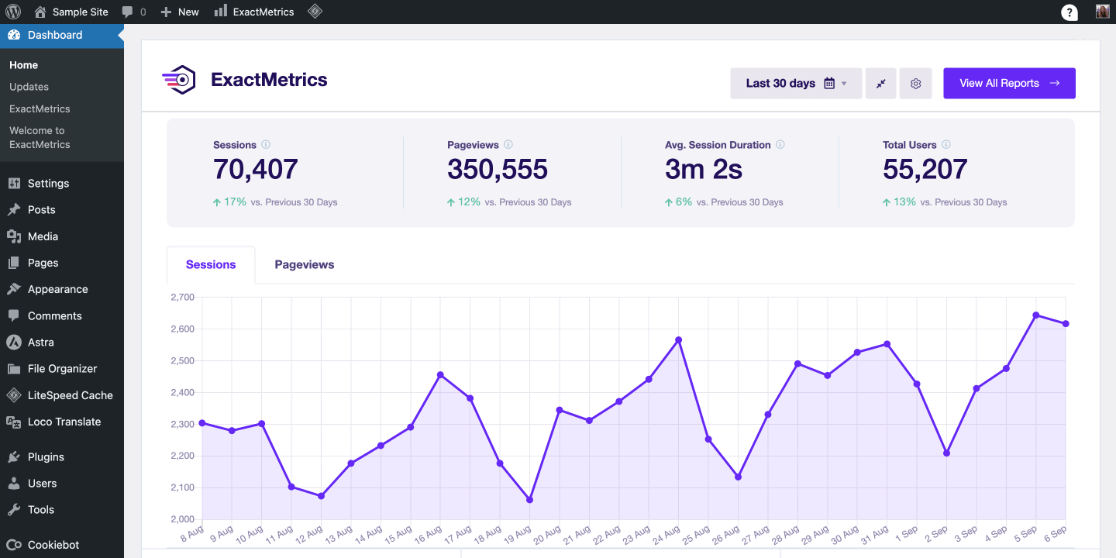Embedding videos on your WordPress site is one of the most effective ways to engage your audience and keep them on your pages longer. If you’re wondering how to embed videos in WordPress, you’ve come to the right place.
I’ve helped many site owners add videos to their WordPress sites, and I’ve found that it’s simple to do and significantly benefits your site’s performance.
In this guide, I’ll walk you through 3 easy methods to embed videos in WordPress and show you how to track video performance effectively. By the end, you’ll know exactly how to add video in WordPress without touching a single line of code.
Table of Contents:
- Why Should You Embed Videos in WordPress?
- How to Embed Videos in WordPress
- How to Track Videos in WordPress
- Frequently Asked Questions
Why Should You Embed Videos in WordPress?
Embedding videos into your WordPress website can enhance its visual appeal and functionality. Let’s dive into why embedding videos is a game-changer:
- Keeps visitors engaged: Videos can grab attention in ways that text and images can’t. They encourage visitors to spend more time on your site and improve engagement.
- Improves SEO: Search engines love video content. Including videos can help your site rank higher in search results.
- Enhances learning: Some people learn better by watching. Videos can make complex topics more straightforward to understand.
- Increases sharing potential: Videos are easy to share. They can help your content reach a broader audience on social media.
- Saves loading time: Hosting videos on platforms like YouTube and embedding them on your site can save your site’s bandwidth because the video file is not stored there. This helps with your website’s speed.
- Professional appearance: High-quality videos can make your site look more professional and trustworthy.
- Easy to update: Embedding videos means you can update the video content on the hosted platform without changing your website.
As you can see, there are a ton of great reasons why embedding video content on your WordPress site is a smart move. From making your site more engaging and informative to improving your SEO and making updates a breeze, videos offer a dynamic way to enrich your website’s experience.
So, incorporating videos is the way to go, whether you are aiming to educate, entertain, or elevate your site’s performance.
How to Embed Videos in WordPress
Now that you know why it’s a great idea to embed video content on your WordPress website, let’s take a look at the best ways to do so. Here are the 3 methods I’ll cover below:
- Method 1: Using a Plugin
- Method 2: Using the WordPress Classic Editor
- Method 3: Using the WordPress Block Editor
Method 1: Using a Plugin
The easiest way to insert video to WordPress is by using a media plugin. Plugins are fantastic tools because they allow anyone to add complex features to their websites with just a few clicks, regardless of their technical know-how.
For those wondering how to embed YouTube video into WordPress, Smash Balloon’s YouTube Feed Pro is the best choice and the method I’ll use in this tutorial.
Smash Balloon is also best for embedding Instagram, Twitter, Facebook, TikTok, and Reviews Feeds.
YouTube is the most popular video hosting platform, and it offers a vast array of content that can be directly showcased on your website through Smash Balloon.
Whether it’s videos from your own YouTube account or someone else’s, or even videos based on specific search terms, this plugin makes it all possible with various display options like galleries or individual videos.
Step 1: Install and Activate YouTube Feed Pro
To kick things off, you’ll need to install Smash Balloon’s YouTube Feed Pro plugin.
Start by purchasing the YouTube Feed Pro license from the Smash Balloon website. The Personal plan should cover all the essentials for embedding videos on a single website.
After purchasing, download the plugin from the My Account » Downloads page on the Smash Balloon website. Don’t forget to copy your license key from the same page; you’ll need it shortly.
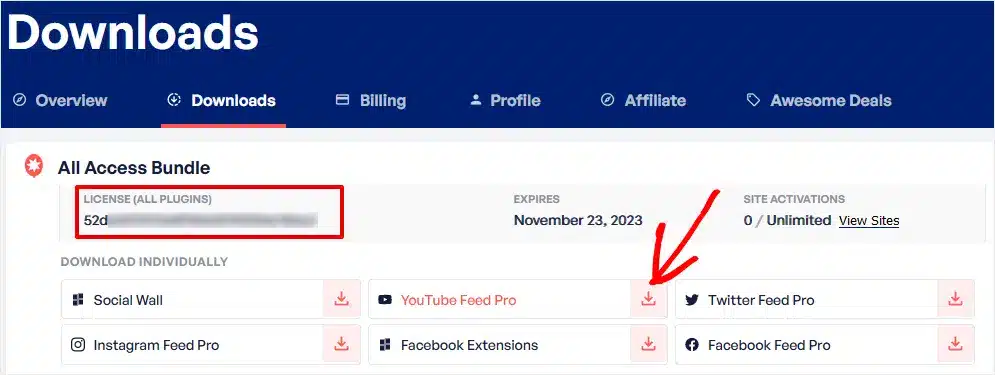
Once you’ve downloaded the plugin, upload and activate it on your WordPress site. If you need help, read this guide on how to install a WordPress plugin.
You’ll know it’s working when you see a new YouTube Feed item in your WordPress dashboard menu.
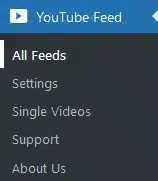
The next step involves activating your plugin. Navigate to YouTube Feed » Settings and paste the license key you previously copied. Click Activate to complete this part of the setup.

And that’s it! You’re now ready to create a YouTube Feed that you can embed in WordPress.
Step 2: Create a YouTube Feed
Creating a new YouTube feed is your next task.
Go to All Feeds and click on Add New.
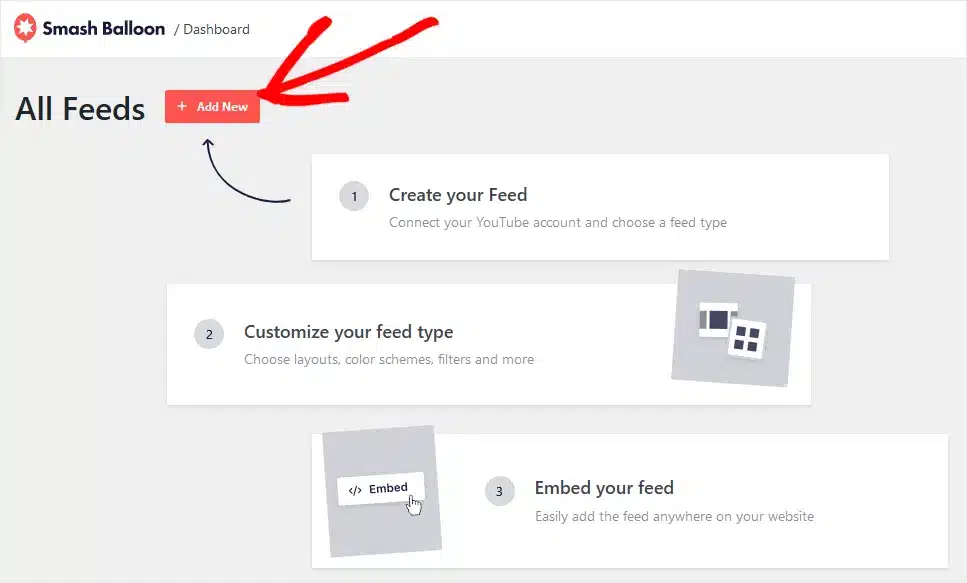
You can create different feed types like Channel, Playlist, Favorites, Search, Live Streams, and Single Videos.
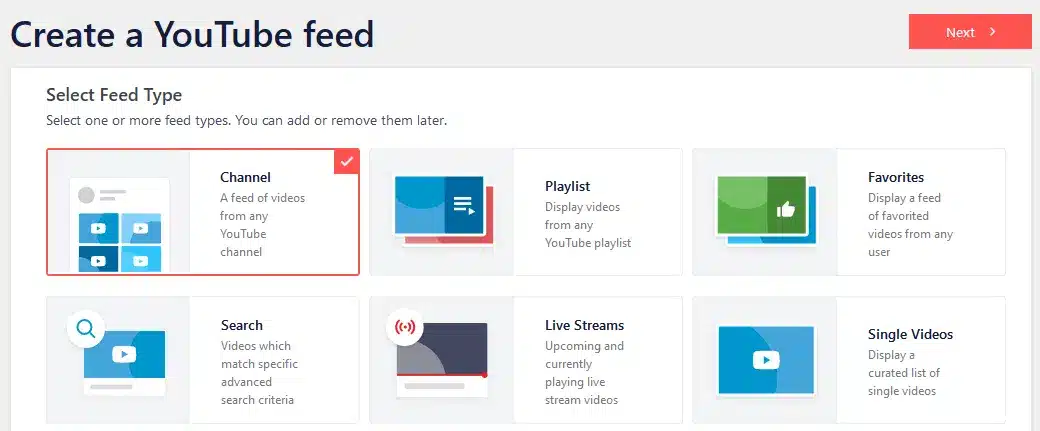
Select the one that fits your needs and connect your YouTube account by entering your Channel ID or Username.
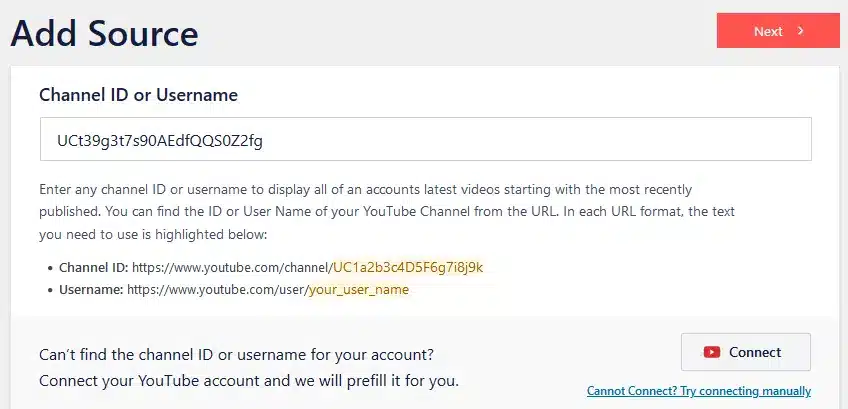
Once you’ve inserted your Channel ID or Username, click Connect.
The last step requires you to enter a YouTube API key for verification or to connect with a YouTube account.
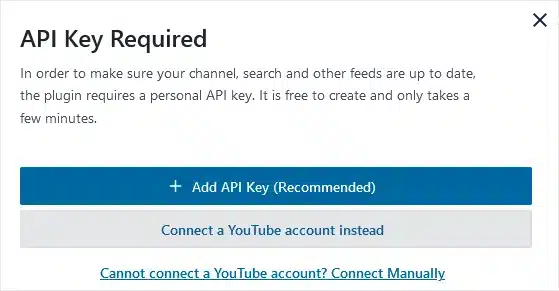
The best way is to use an API key, a straightforward process for verifying your account. If you don’t have one, follow this simple guide to get an API key from Google.
Now, you’re ready to design your YouTube feed.
Step 3: Design and Customize Your YouTube Feed
After connecting your account, select a template and customize your video feed to suit your site’s aesthetics. You can always go back and change this later if you want.
Pick one to get started and click Next.
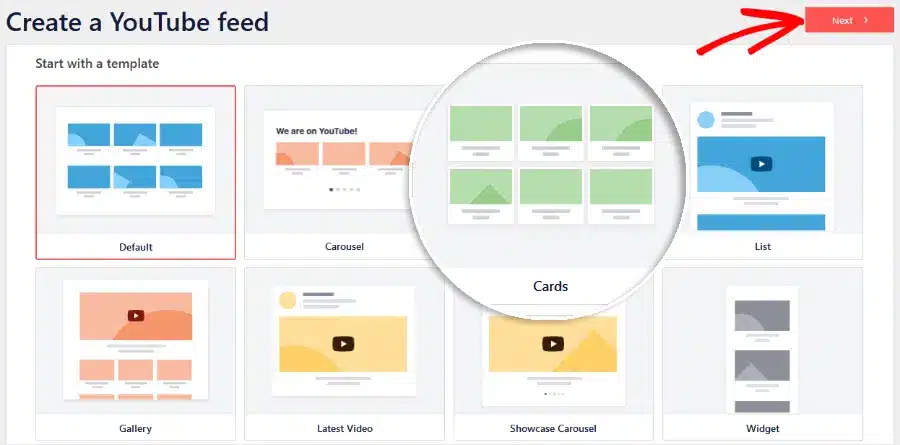
Smash Balloon offers a variety of customization options, allowing you to adjust layouts, colors, headers, and the appearance of buttons and the video player.
You have all your customization options on the left and a live preview of your YouTube feed to the right.
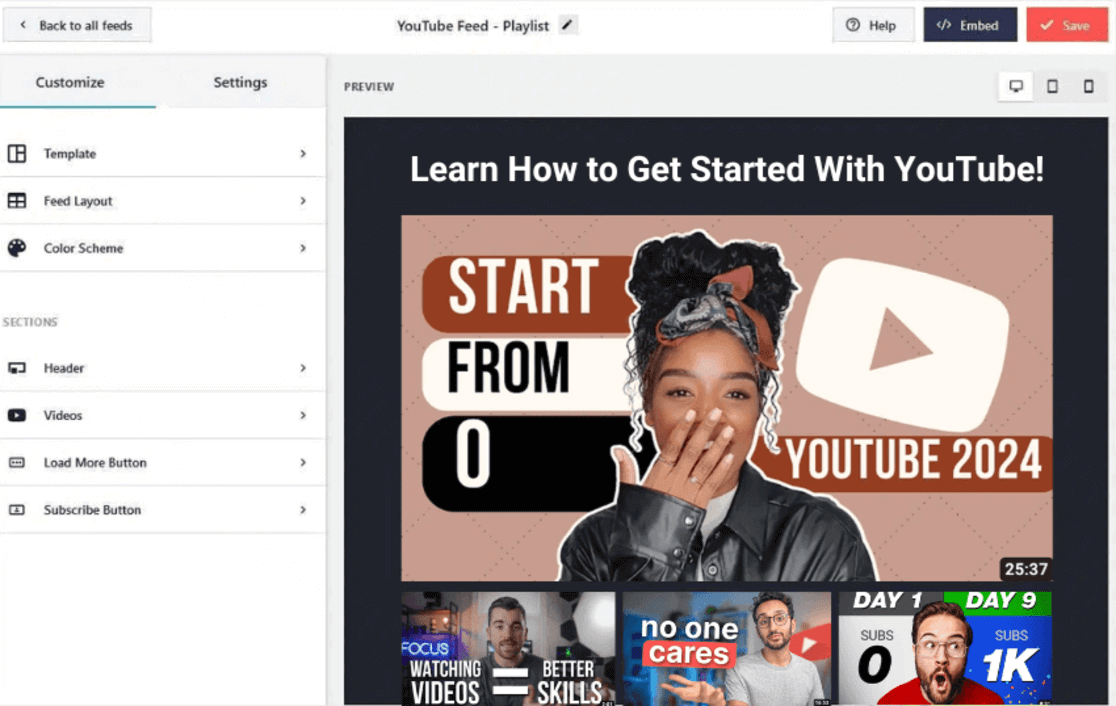
Go through the different sections and categories and play around with your design. Once you’re happy with how your feed looks, click Save.
Step 4: Embed Your YouTube Feed
Since you’ve created a stunning YouTube Feed, embedding it onto your WordPress site is the last step.
You can do this by clicking the Embed button in the feed editor.
You’re presented with three methods to embed your video feed into your site.
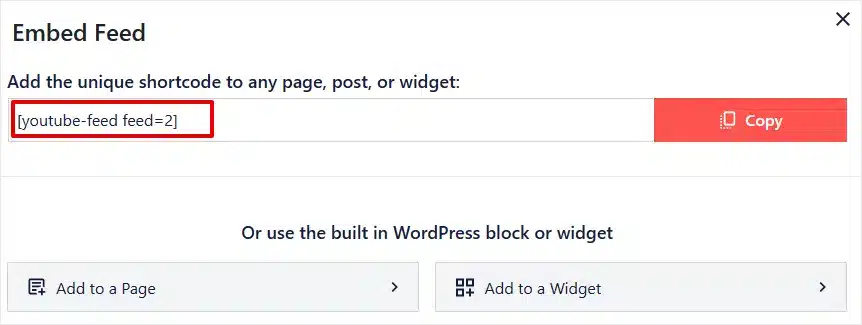
Initially, you have the option to use a shortcode. Copy this shortcode and insert it into any page, post, or widget you choose.
Next, there’s an Add to a Page feature. By selecting this, you’ll view a list of your live pages.
Choose the page you want to enhance, hit Add, and you’ll be directed to edit mode. Here, you’ll be asked to choose a block called Feeds for YouTube.
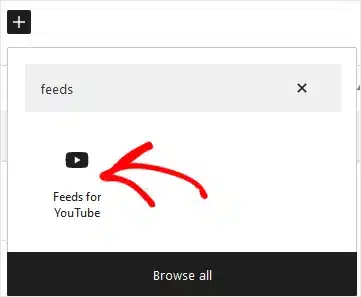
A simple click on this block automatically embeds your feed into the selected page.
Lastly, for those looking to embed the video feed into a WordPress widget, the Add to a Widget option is available.
This action opens the Widgets area, creating a new widget containing your shortcode. You’re then free to place this widget in various spots across your site, like the sidebar or footer, based on your preference.
Using a plugin like Smash Balloon’s YouTube Feed Pro simplifies the process of embedding YouTube videos into your WordPress site. This method allows you to create great-looking YouTube feeds and embed them in WordPress without touching a single line of code.
You’ve now learned how to embed videos in WordPress using a plugin. Now, we’ll look at two methods without.
Method 2: Using the WordPress Classic Editor
Even if you’re using WordPress’s older classic editor, embedding videos is straightforward.
The classic editor in WordPress features two tabs: Visual and Text.
When working in the Visual tab, embedding videos is as simple as pasting the video’s shareable URL link directly onto the page, provided WordPress supports the video hosting service.
This means the Visual tab functions similarly to the block editor. Just insert the video’s URL link into your content, and WordPress automatically embeds the video.

On the other hand, embedding a video through the Text tab involves a different process since direct URL links won’t work here. Instead, you’ll need the specific embed code from your video hosting platform.
Take YouTube, for example. Click the Embed button within the Share options to get the embed code.
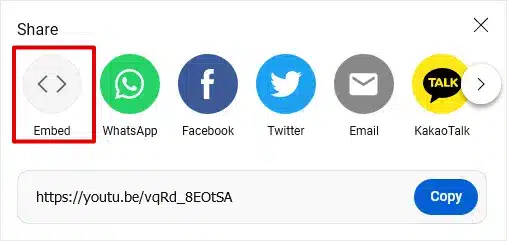
This action reveals the necessary embed code.
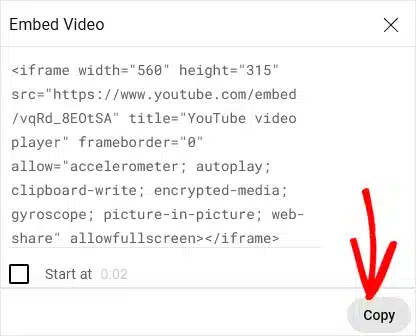
Copy this code and paste it into the desired location on your WordPress page using the Text tab. After saving your changes and previewing, your video will be successfully embedded and ready.
Method 3: Using the WordPress Block Editor
For anyone using the WordPress block editor, there’s another easy method to embed videos.
Select a video you wish to embed from YouTube or any other compatible service. For instance, on YouTube, this action will bring up a box with a link ready to be copied – press the Copy button to grab it.
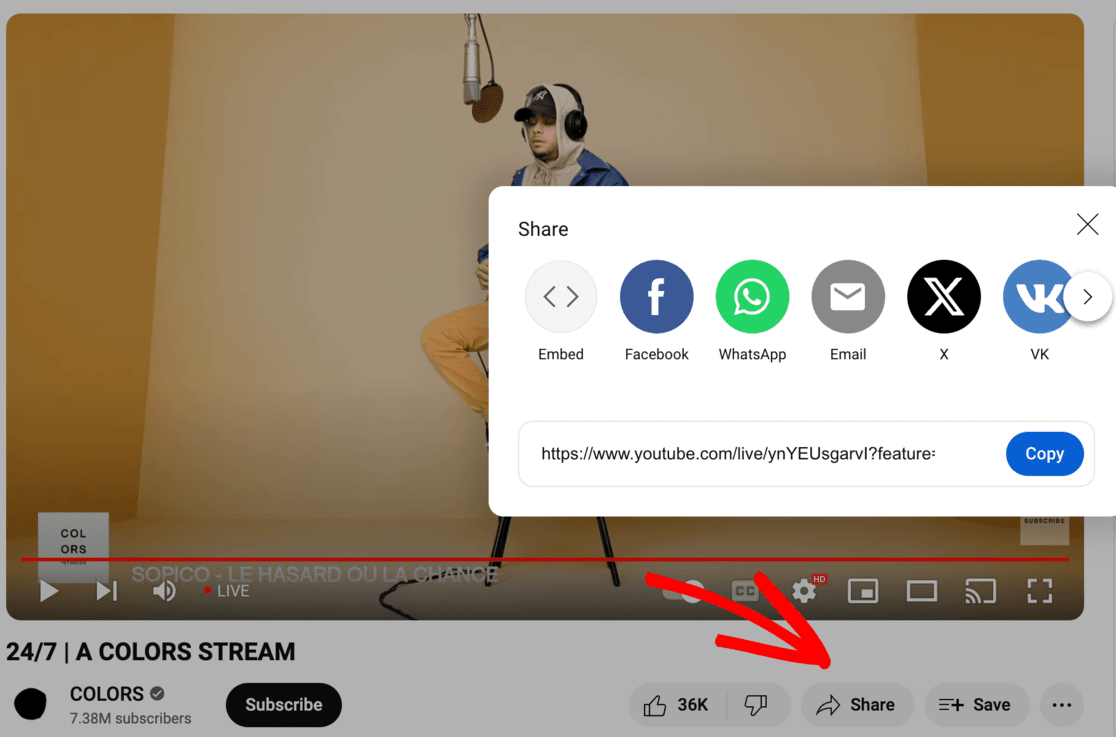
Next, navigate to the page or post editor in WordPress where you want the video to appear. Although you can choose a specific block, simply pasting the link into a Paragraph block works, too.
WordPress is designed to recognize the video service and adjust the block type if supported.
For example, here’s how you would share a link from Vimeo:
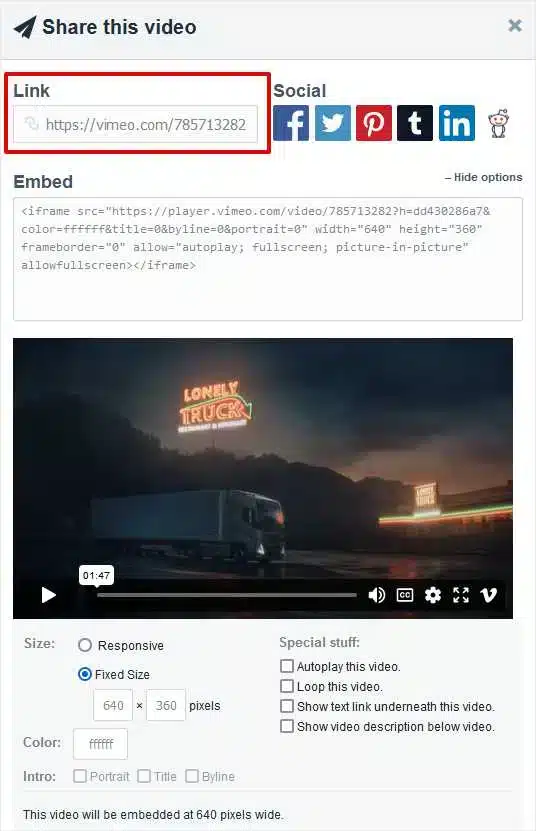
Just paste the copied link directly into the WordPress block editor. If the video embeds successfully, there’s nothing more you need to do!
Should the video not be embedded, it might be because WordPress doesn’t support that particular video service.
WordPress offers a variety of <embed> blocks for different platforms, such as YouTube, Animoto, Vimeo, and others, plus a general Embed block for services not automatically recognized.
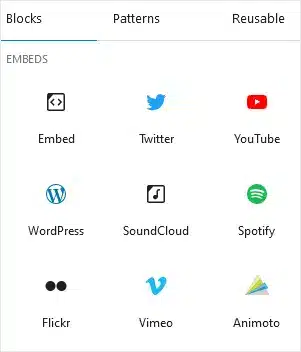
To use a specific video platform’s native block, look for it by name in the block selector. Once added to your WordPress editor, paste the video URL into the designated field.
Here’s an example using the Vimeo block:

Paste in the video URL and click Embed.
And there you have it – a straightforward approach to embedding videos in WordPress using the block editor.
How to Track Videos in WordPress
As your videos attract more visitors to your site, you’ll be interested in understanding how viewers interact with your content.
With ExactMetrics, the premier Google Analytics plugin for WordPress, tracking your video engagement directly from your WordPress dashboard becomes a breeze.
ExactMetrics automates the video tracking setup, eliminating the need for manual code or tag integration on your site.
ExactMetrics facilitates tracking for YouTube, Vimeo, and HTML5 videos within WordPress, making it a versatile tool for content creators.
To unlock the full potential of video analytics, you’ll need to upgrade to the ExactMetrics Plus plan or higher.
Once the ExactMetrics plugin is installed, activating the Media addon is your next step. This addon grants access to the comprehensive Media report.
To view your video engagement metrics in ExactMetrics, navigate to ExactMetrics » Reports and select the Media tab.
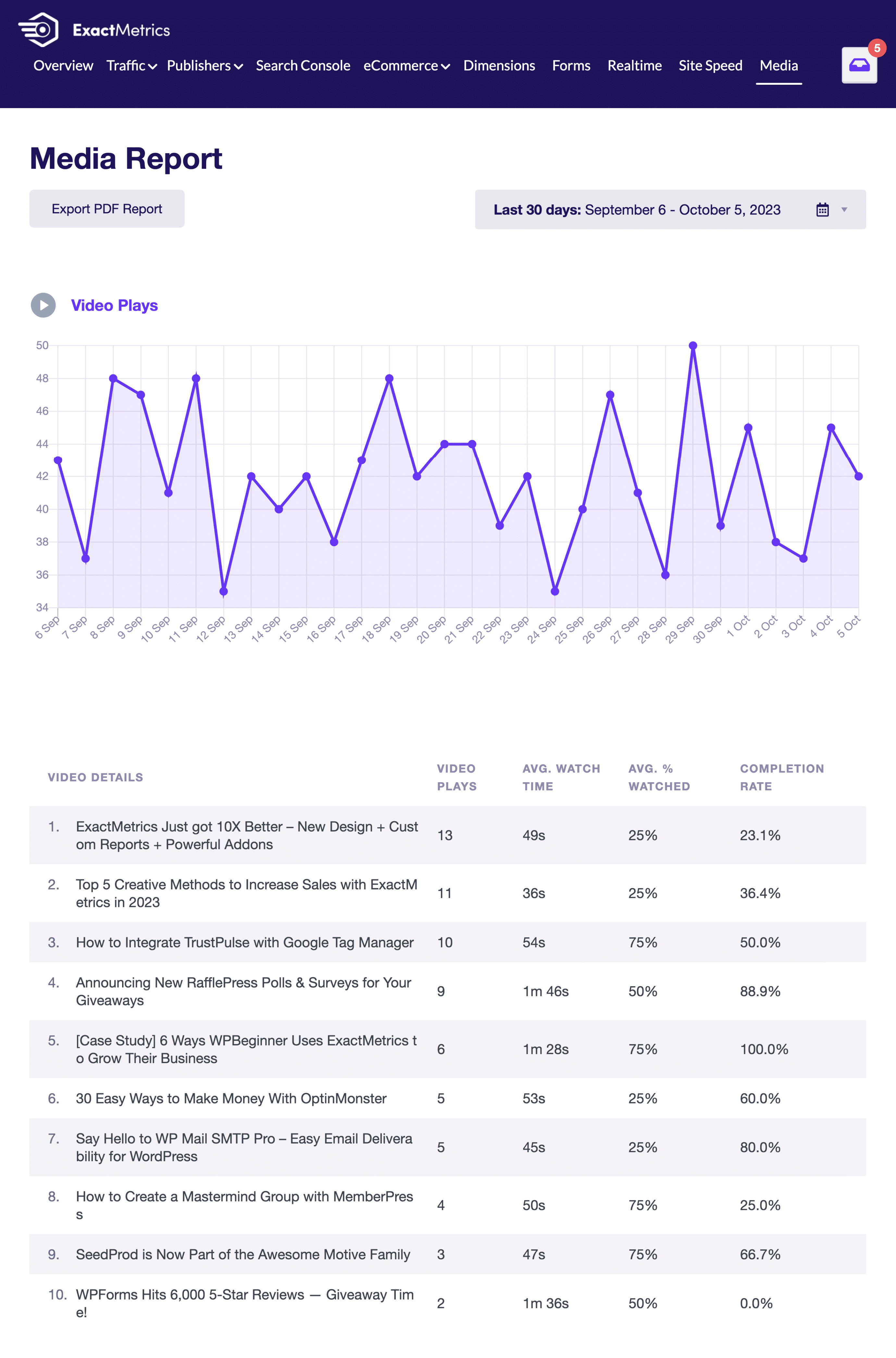
Here, you’ll see a detailed report displaying the daily count of video plays. Additionally, a breakdown of individual videos shows the number of plays each received, alongside advanced analytics such as:
- The average duration of watch time in minutes
- The average percentage of the video that was viewed
- The proportion of viewers who watched the video in its entirety
This information is invaluable for optimizing your video content strategy. For instance, replacing videos with low engagement or analyzing content for points where viewers tend to drop off is an excellent indicator of where you can make improvements.
Not only that, but if you’re running ads on Facebook (Meta) or TikTok, ExactMetrics lets you effortlessly track those ads using Pixel ID tracking. By using UTM parameters, users have a clear view of how their campaigns are performing in the campaigns report:
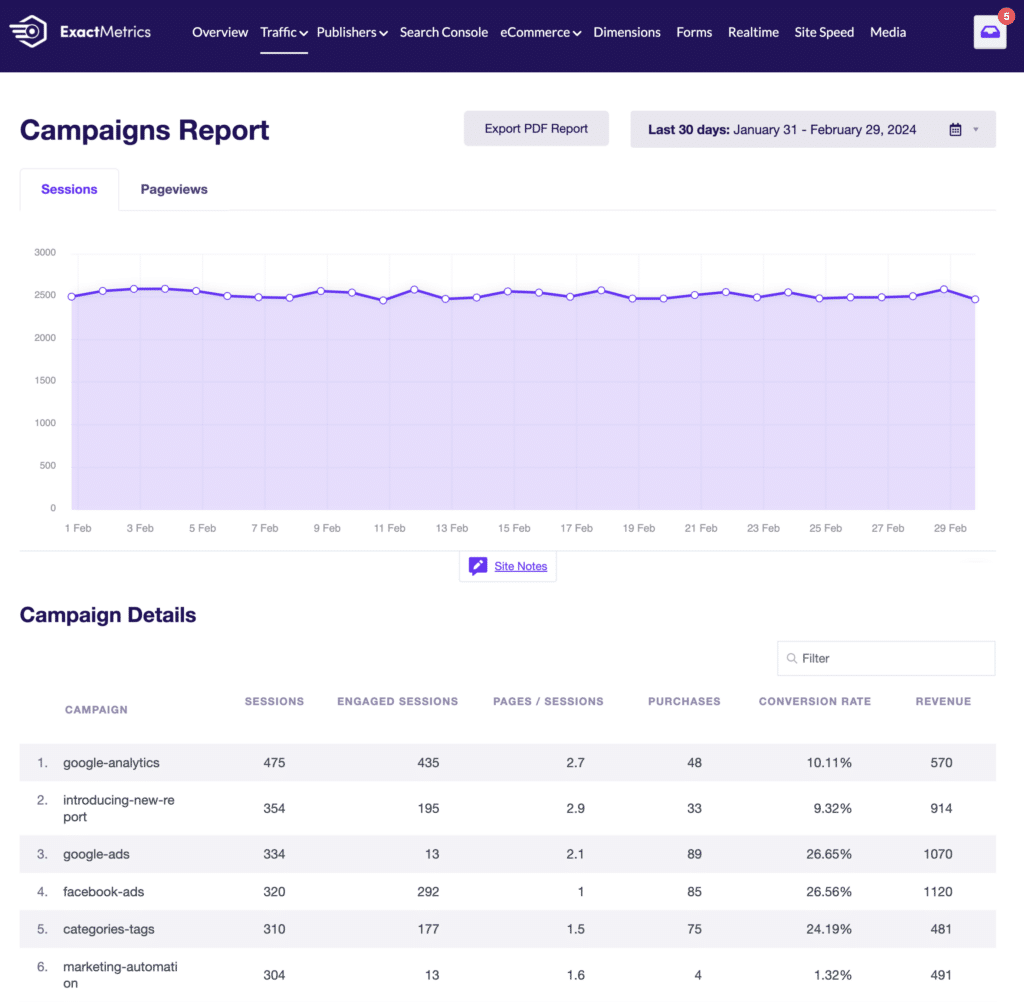
With ExactMetrics, not only do you get specific data on video performance, but you also have access to a wealth of features and Google Analytics data way beyond just video tracking.
Get started with ExactMetrics today!
Frequently Asked Questions
Can I embed a video on a WordPress site without a plugin?
Yes, you can embed videos without a plugin by pasting the video URL directly into the WordPress block editor or by using embed codes in the classic editor.
How do I embed a YouTube video in WordPress?
To embed a YouTube video, copy the video URL from YouTube and paste it directly into your WordPress post or page. WordPress will automatically convert it to an embedded player.
Can I embed a video that’s not from YouTube or Vimeo?
Yes, WordPress supports many video platforms, including Dailymotion, Facebook, and TikTok. For unsupported platforms, you can try using their embed code in a Custom HTML block.
Where can I find the embed code for a video?
Most video platforms provide an “Embed” or “Share” option near the video. Click on that to get the embed code you can use in WordPress.
Can I track how many people watch my embedded videos?
Yes, with tools like ExactMetrics (Plus plan or higher), you can track video views, watch time, and completion rates directly in your WordPress dashboard.
How do I embed a video gallery in WordPress?
The easiest way to embed a video gallery is with a plugin like Smash Balloon’s YouTube Feed Pro, which allows you to create customized video galleries from YouTube channels or playlists.
That marks the end of my tutorial on how to embed videos in WordPress.
I hope you found this guide useful. If you liked it, read 7 Best WordPress Video Plugins (Free + Paid).
Haven’t tried out ExactMetrics yet? Get started today!
Remember to follow us on X and Facebook for all the latest reviews, tips, and tutorials.



